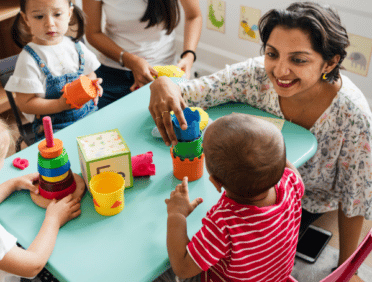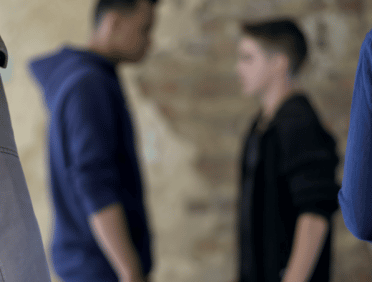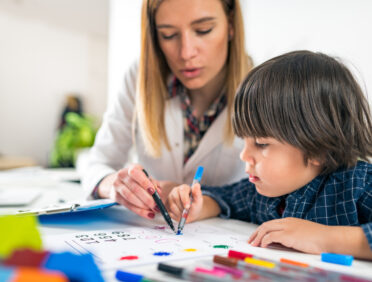Every organisation that works with children or comes into contact with them needs to have proper safeguarding policies and procedures in place. These procedures help to guarantee that every child, regardless of age, gender, religion, sex, gender reassignment, race, belief, disability or sexual orientation, has the right to be given equal protection from neglect or abuse.
As a result, it is important for companies to not only create but enforce proper safeguarding policies which help to protect children from other children and adults who may pose a risk to them in any way. This can include things like faith groups, community organisations, schools, sports clubs and private sector organisations.
What is a Child in Need Of Safeguarding?
We define safeguarding as being the action which is taken to protect children. Specifically, safeguarding is all about the actions which are taken to protect the well-being of children and help to keep them safe from harm.
Safeguarding, in a general sense, refers to many different things. First of all, it is all about protecting children from the risk of abuse and maltreatment. Second of all, it is about helping to prevent any risk of harm to the development or health of children. Third of all, it is about making sure that children grow up with access to the best possible provision of effective and safe care. Finally, it is all about making sure that children and young people can take action to get the best outcomes in their lives.
Child protection forms a core part of the safeguarding process. It focuses mostly on helping to protect individual children from harm. Broadly speaking, these children are often identified as either suffering from or being likely to suffer from significant harm or abuse. These safeguarding practices can include child protection procedures, which are procedures that help to detail what somebody must do if responding to a concern about a child.
What is the Difference Between Child Protection and Children in Need?
The primary difference between child protection and children in need is the severity of the support that is on offer. A child in need is considered to be a less severe case and thus does not have access to the same resources.
The child in need plan is a voluntary plan for families. It gives children access to extra resources beyond what every child receives automatically to help them develop in a safe, suitable environment.
The child in need plan operates under section 17 of the children act 1989. However, this does not have a statutory framework for the timescales regarding intervention. Furthermore, the threshold for accessing services is much lower than it would be for a child protection plan.
Meanwhile, a child protection plan operates under section 47 of the children act 1989. This is most likely to occur when a child is regarded to be suffering significant harm or is at a pronounced risk of suffering harm. The procedures for child protection have clear frameworks, which are outlined in statutory guidance documents.
This begins as an initial child protection conference, where professionals will make a joint decision to identify whether or not the child meets the threshold for a section 47 child protection plan. There are then meetings composed of core groups who discuss the progress of the child and set a review for child protection within a given timeframe.
It is probably important to note that the child protection service is not voluntary for families. It is enforced by the local authority, with the use of police if necessary, and is coupled with intensive support. It should also be observed that at any point during either of the two processes, the local authority can decide that the child is no longer safe to be living with carers or parents, and they may wish to petition the court to grant an order releasing the child from the care of their guardians and entrusting them to the local authority instead.
What is The Difference Between Sections 17 and 47 in the Children’s Act?
The difference between section 17 and section 47 in the children’s act is all about the type of plan that is put in place depending on the threat to the child that is assessed.
Section 17 of the children act 1989 refers to what is known as a child in need plan. This is considered to be the less severe of the two plants, does not possess a statutory framework for intervention, and generally has a much lower threshold of accessible services that would be available for a child protection plan.
The other important player in the equation is a child protection plan, which is part of section 47 of the children act 1989. This is a plan which is statistically most likely to occur when the child in question is considered to be at risk of suffering neglect or abuse or is already a victim of neglect and abuse. Unlike a child-in-need plan, this has a well-defined statutory framework, and there are many more resources that can be accessed as part of the plan.
Children in Need Awareness Raising
It is important to try and raise awareness of children in need and to demonstrate knowledge that they are often given fewer resources and taken less seriously simply on account of how their situation has been defined.
Early Help and Safeguarding
Early help is also known as early intervention and is the term given to support which is offered to a family when a problem first becomes apparent. This is guidance and support which can be provided at any stage in the life of a child or young person’s life.
The statutory guidance in each nation of the U.K. makes reference to the importance of early intervention. Acting now, instead of waiting until the situation escalates into actual harm for the child, is often considered to be the best course of action for making sure that they get the support necessary.
To this effect, there are a lot of early help services on offer. These can all be used to deliver support to parents, their children, or entire families, depending on the situation. However, the primary focus will always be to provide support and favourable outcomes for the children in the situation.
To list a popular example, there are services that support parents living in especially challenging circumstances. The resources provided help them to give their kids the best environment to live in. Alternatively, in the event that a child begins to display risk-taking behaviours, the early help practitioner might work directly with the parents and the child in question to identify the reasoning for the behaviour and then develop strategies which help to keep the child safe.
It’s pretty important to try and provide support to a family in a timely fashion during this period. Taking the time to address the needs of the child or their family early on helps to reduce the risk factors in the life of the child and increase the protective measures that are in place for them.
There are quite a few protective factors at work which can help to reduce the risk to the well-being of a child. These include things like developing emotional and social skills, having a strong support network in place for a family unit, supporting parental mental health, offering income support, benefits and advice, and making sure there is access to suitable community services and facilities.
When dealing with these types of problems, it is important to offer early help in advance when problems first crop up than to try and react to issues developing later. Early intervention can be a good tool to prevent further issues from developing, after all. As an example, it is possible to make sure that a support plan is in place for a child when that child returns home from care that helps to make the right environment for parents and their kids.
There are quite a few types of early help, which can take the form of things like mentoring schemes, home visiting problems, school-based programs, and other offerings. When referring to early health services, they should be part of an ongoing continuum of support that is created to help practitioners respond to the different types of leads that children and their families may have.
When it comes to looking at early health services, it’s important to make sure that they are holistic, addressing the wider needs of a family and providing appropriate support where necessary.
Early help it’s a very important part of safeguarding, as it can provide children with the support they need to register for potential. It can drastically improve the overall quality of a child’s family and home life, helping them to perform better in school, and providing them with much-needed mental health support.
Research suggests that early help in intervention can reduce the need for a referral to child protection services, help protect against harm, and improve the long-term outcomes that a child may have. Furthermore, early help is a good way to make sure the child has strengths and skills that can help prepare them for adult life.
Early Years Safeguarding
Taking the time to protect children during their formative years is the best way to make sure that they are free from risks to their mental health or separated from the risk of abuse and neglect.
A lot of dangers can be present during the early years of a child’s life, and this is when they are at arguably their most vulnerable, which is why it can be important to make sure that there are proper early years safeguarding strategies in place.
Child Criminal Exploitation (CCE)
Child Criminal Exploitation, known to others as CCE, is a growing concern which crops up when children and younger people become the target of gangs and criminals. These vulnerable parties are put into positions where they may have to do something dangerous and are often used to engage in criminal activity such as smuggling drugs or weapons.
Child Sexual Exploitation (CSE)
Child sexual exploitation is an issue which is just as severe as criminal exploitation but is geared more toward exploiting children for personal gain. Children may be groomed to participate in illegal and harmful sexual activities or be used as part of a sex trafficking ring.
Female Genital Mutilation (FGM)
Female genital mutilation is a dangerous act which can involve performing surgical procedures on the sexual organs of a child that leaves them with permanent damage. It can be done by many parties including parents and often requires extensive surgery to undo. Make no mistake, it is a serious safeguarding concern and a crime.
Unfortunately, it’s often the case, especially in less economically developed parts of the UK, that children are used for modern slavery purposes.
Naturally, child trafficking is child abuse. It is defined as the moving on my recruiting, receiving and harbouring children for the purposes of exploitation. Child tracking is synonymous with modern slavery. While many children are trafficked into the UK from abroad, there are many children who are trafficked from one part of the UK to another.
Children can be trafficked for a number of reasons. Street crime, benefit fraud, immigration fraud, forced marriage, child sexual exploitation, and domestic servitude are all prime examples.
Family Support
Family support is definitely an important part of safeguarding. It’s necessary to provide support for families to help them cultivate the right situation and environment in which children can have a safe, loving upbringing.
There will be many situations where children need access to more resources than are usually provided, and this is absolutely fine family support is all about making sure that the members of the family have access to the resources that they need to take care of their children, and to work with them to make sure the problems are dealt with before they become serious.
Social Workers
Social workers play an important role within the confines of a local authority by helping them to regulate and protect young children and vulnerable adults from neglect or abuse. Social workers are often part of the NHS and can perform a wide range of roles.
Why Should I Help Children in Need?
You may not think that the responsibility of helping children in need applies to you, but it does. Safeguarding works under the principle that everybody has a responsibility to help children in need.
The basic idea is that even if you are not directly working with children if you are indirectly connected to them, you have a responsibility to help them. You have a responsibility to observe behaviour and to point out any behaviour you consider to be a safeguarding concern.
Safeguarding Training from Learn Q
Learn Q is committed to providing safeguarding training, such as Safeguarding Children & Young People Level 1 and Level 2. We want to make sure that everybody understands the importance of protecting children in need and how to do so.
This kind of training is very important for anybody who is hoping to pursue a meaningful career working with children, which is why it can be very important to be able to get the best results. Thankfully, we are here to help, and we can provide an education for your entire staff if necessary. This kind of training is easy enough to provide but very important. Therefore, it’s well within the interest of your business to get as many people trained in this type of safeguarding as possible.
To download a .pdf of this blog, please click here












